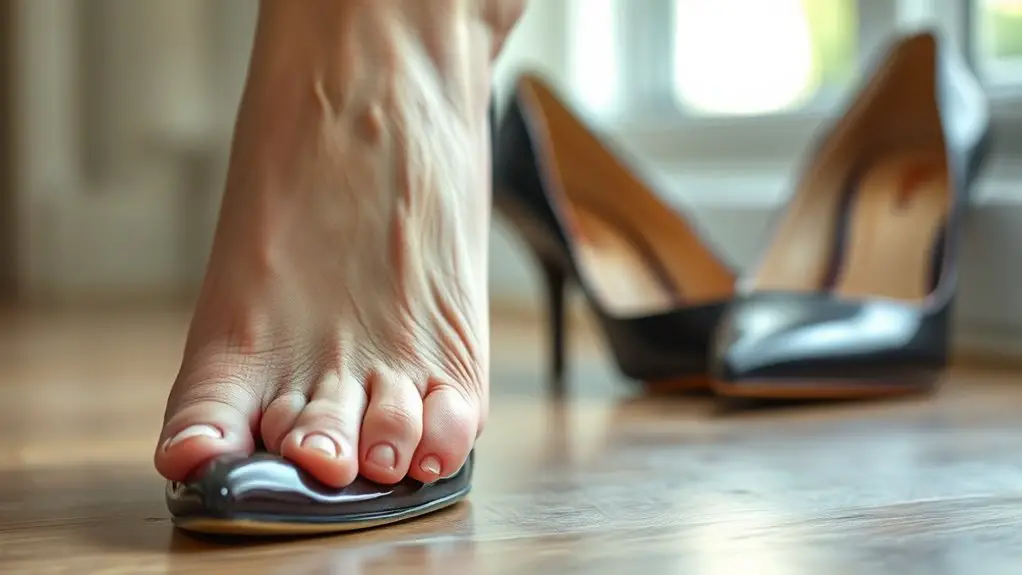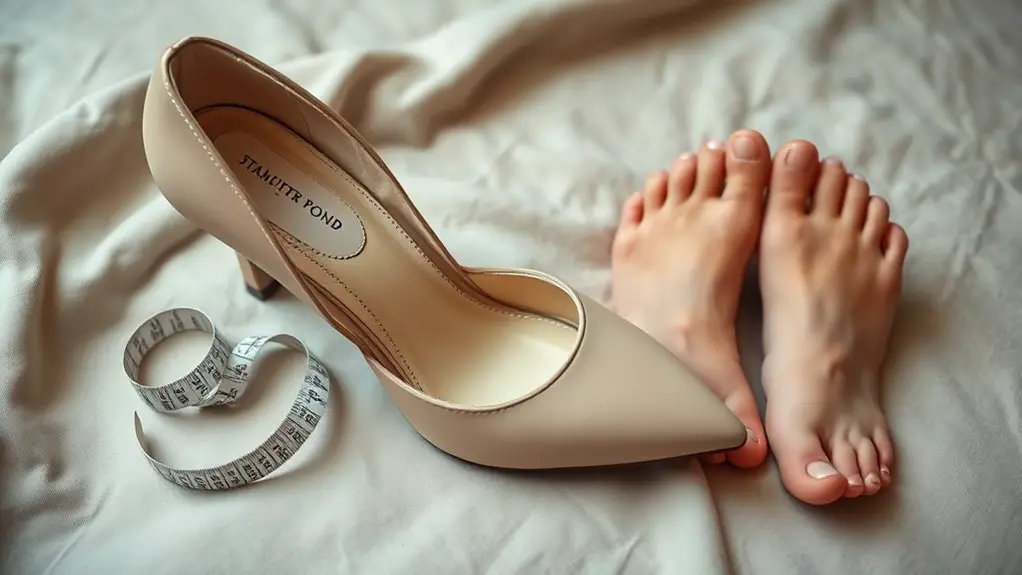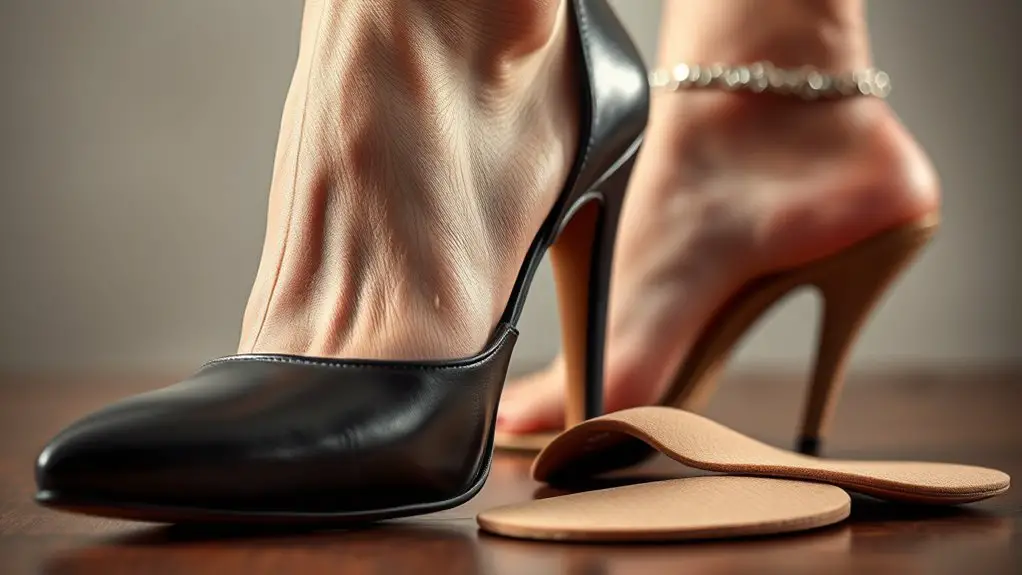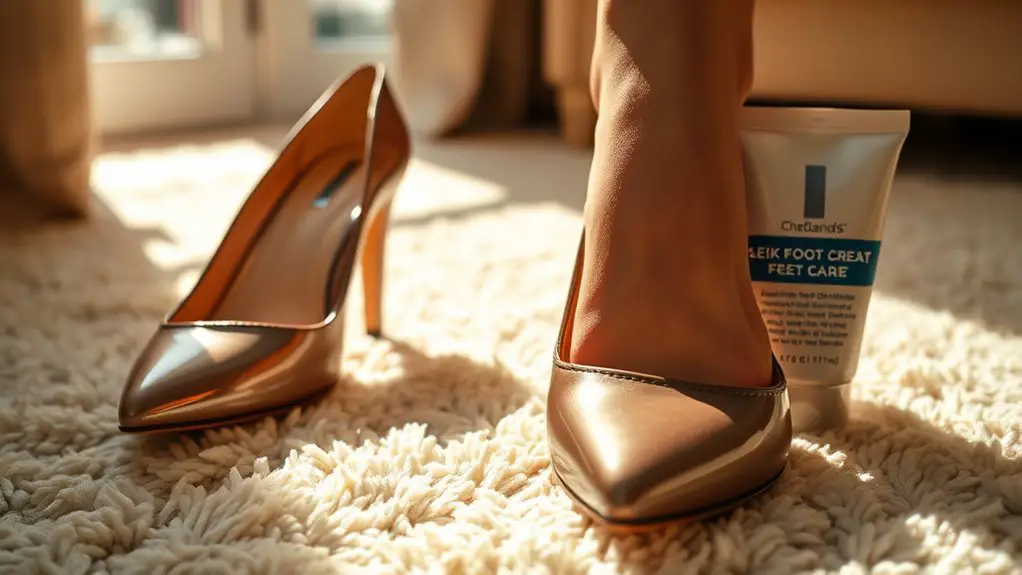Tight-fitting heels often result from improper shoe size, insufficient arch support, and shoe designs that don’t accommodate your unique foot structure. When shoes pinch or place excessive pressure on your feet, it’s essential to assess both size and fit. Additionally, rigid materials and insufficient cushioning can exacerbate discomfort. To alleviate tightness, consider stretching your shoes and choosing suitable materials. Discover more approaches to enhance comfort and prevent discomfort throughout the day.
Understanding the Anatomy of Your Feet

Understanding the anatomy of your feet is essential for addressing discomfort caused by tight heels. Your foot structure consists of bones, muscles, tendons, and ligaments that work together to support your body. The three primary arch types—high, medium, and low—play a significant role in how your feet interact with footwear. High arches may create pressure points, while low arches can lead to overpronation, affecting how shoes fit.
When selecting heels, consider your arch type, as it influences the distribution of body weight and pressure across the foot. A mismatch between your foot structure and shoe design can result in discomfort. Additionally, understanding your foot’s anatomy helps in identifying the best materials and styles for support, ensuring a more comfortable fit. By being aware of these factors, you can make informed choices that prioritize comfort while wearing heels.
Common Reasons for Tight-Fitting Heels
When you slip into a pair of heels, discomfort can often stem from several common factors contributing to a tight fit. One primary reason is your foot shape; if your feet are wider or have a high arch, standard heel designs may not accommodate them properly. This mismatch can lead to pinching and pressure points. Additionally, insufficient arch support can exacerbate the problem, as it can cause your foot to flatten, further straining the shoe’s fit. Inadequate cushioning might also contribute to discomfort, especially in styles lacking proper padding. The materials used in the shoe can play a role too; stiff or unforgiving materials may not stretch adequately over time. Finally, the heel height can impact how your foot is positioned, creating additional pressure that can lead to tightness. Recognizing these factors can help you make informed choices when selecting heels that fit comfortably.
The Importance of Proper Shoe Size

Understanding your proper shoe size is essential for comfort and foot health. You should measure both your foot length and width to guarantee a correct fit, as many people overlook width considerations. Always try shoes on before purchasing to assess their fit accurately, as sizes can vary considerably between brands.
Measuring Your Foot Size
Properly measuring your foot size is essential for finding the right shoe fit and preventing discomfort. To guarantee accuracy, use foot measurement techniques like tracing your foot on paper or using a Brannock device. These methods help you obtain both length and width measurements. Additionally, it’s important to focus on determining arch types, as this can greatly affect shoe selection. Arches can be categorized into low, medium, or high, influencing how shoes fit and feel on your feet. Measuring your foot while standing can also provide a more realistic size, as your feet naturally expand under weight. Taking these steps will guide you toward selecting shoes that accommodate your unique foot structure, enhancing comfort and overall foot health.
Shoe Width Considerations
Although many people focus primarily on foot length, shoe width is equally critical for achieving a comfortable fit. Different shoe types cater to various foot shapes, making it essential to find the right width. A shoe that’s too narrow can cause discomfort and exacerbate tightness, especially in heels.
| Shoe Type | Common Foot Shapes | Recommended Widths |
|---|---|---|
| Sports Shoes | High arches, wide feet | D, 2E |
| Dress Shoes | Narrow feet | B, C |
| Casual Shoes | Average feet | D |
| Boots | Wide calves, flat feet | E, EE |
| Sandals | All shapes | Adjustable width |
Understanding these considerations can help you select appropriate footwear, enhancing both comfort and performance.
Trying Before Buying
Finding the right shoe width is just one part of achieving a comfortable fit; trying on shoes before purchasing is equally important. Engaging in proper shoe testing allows you to assess how the shoe feels on your foot during movement. A fit assessment should include walking around the store, paying attention to any tightness or discomfort, particularly in the heel area. Make certain you’re wearing the same type of socks you’ll use with the shoes, as this can affect the fit. Remember, different brands may have varying sizing standards, so don’t assume your usual size will work. Taking the time to try on shoes guarantees you’ll avoid potential pain and discomfort, leading to a more enjoyable wearing experience.
How Shoe Design Affects Fit

Shoe design plays an essential role in determining how well a shoe fits, as various elements such as shape, material, and construction directly influence comfort and support. Different shoe shapes cater to diverse foot anatomies, and a mismatch can lead to tightness, especially in the heel area. For instance, a narrow toe box can compress the forefoot, pushing your heels deeper into the back of the shoe. Design trends often prioritize aesthetics over function, which can exacerbate fit issues. Materials also matter; rigid materials may not accommodate natural foot movement, leading to discomfort. In addition, the construction techniques used—such as stitching and padding—can impact how a shoe hugs your foot. When evaluating any footwear, it’s vital to reflect on how these design elements align with your foot’s unique shape to avoid unnecessary tightness and discomfort in your heels.
Tips for Stretching Out Tight Heels
If your heels feel too tight, several effective methods can help stretch them out. You can use shoe stretchers, apply heat, or wear thick socks to create more room. These techniques can provide immediate relief and improve overall comfort.
Use Shoe Stretchers
Using shoe stretchers is one of the most effective methods to alleviate tightness in heels. These devices apply gentle pressure to the shoe material, allowing it to expand and adapt to your foot shape. When selecting shoe stretchers, consider those specifically designed for heels, as they target the constricted areas effectively. Insert the stretchers into your shoes and adjust them gradually to avoid overstretching. For best results, leave them in for at least 24 hours. This method guarantees effective stretching without damaging the shoe’s structure. Regular use can help maintain a comfortable fit, preventing future discomfort. By incorporating shoe stretchers into your routine, you can enjoy a more comfortable experience while wearing your favorite heels.
Apply Heat Method
Another effective technique for relieving tightness in heels is the apply heat method. This method involves using heat application to gently stretch the material of your shoes, creating a more comfortable fit. To begin, use a hairdryer on a low setting to warm the tight areas of your shoes for about 30 seconds, keeping it at a safe distance to avoid damage. Once heated, wear the shoes for a short period, allowing them to mold to your feet. You can also consider shoe modifications, such as adding insoles or heel grips, which can further alleviate pressure on your heels. Always verify the heat application is safe for your specific shoe material to prevent any damage.
Wear Thick Socks
One effective way to stretch out tight heels is by wearing thick socks. The increased sock thickness creates a snug fit that enhances the stretching process when coupled with your shoes. As you wear these socks, they’ll apply gentle pressure to the shoe’s interior, gradually loosening the material. It’s important to choose socks that also offer moisture absorption, as this helps maintain foot hygiene and comfort during the stretching phase. Aim to wear the thick socks for several hours at a time, allowing the shoe materials to adapt. Regular use can lead to a more comfortable fit without risking damage to your heels. This method is a simple yet effective solution for alleviating tightness in your footwear.
Choosing the Right Materials for Comfort
When selecting heels that prioritize comfort, understanding the materials used is vital, as they can considerably impact fit and wearability. Choosing the right material types can enhance your overall experience. Opt for breathable fabrics that allow airflow, reducing sweat and discomfort. Look for cushioning options that provide adequate support, especially in the insole. Flexible soles are important, as they enable natural foot movement, minimizing strain.
Leather benefits include durability and a natural stretch, which molds to your foot over time, while synthetic materials may lack breathability and can lead to moisture buildup. Consider eco-friendly materials that not only reduce your carbon footprint but often provide similar comfort levels. Always weigh style versus comfort; a chic design isn’t worth it if it sacrifices your well-being. By focusing on these factors, you can guarantee a more comfortable fit that meets your aesthetic needs without compromising on comfort.
Foot Care Practices for Healthy Feet
To maintain healthy feet, it’s essential to adopt consistent foot care practices that can prevent discomfort and long-term issues. Start with proper foot hygiene; wash your feet daily with soap and water, making sure to dry them thoroughly, especially between the toes. This helps prevent fungal infections and keeps your skin healthy.
Incorporating regular massage techniques can greatly benefit your foot health. Use your hands or a foot roller to apply pressure to different areas, promoting circulation and relieving tension. Focus on the arches and heels, as these areas often bear the most weight.
Additionally, keep your toenails trimmed and filed to avoid ingrown toenails, which can lead to pain and infection. Moisturizing your feet will also help prevent dry skin and cracking. By committing to these practices, you can guarantee your feet remain comfortable and healthy for years to come.
Finding the Perfect Pair: Shopping Tips
Finding the ideal pair of shoes is essential for ensuring comfort and preventing foot-related issues, especially if you’re prone to tightness in heels. Begin by evaluating your style preferences and the specific heel types that suit your lifestyle. High heels may offer elegance but can exacerbate discomfort; consider lower heels or block styles for better support.
When shopping, always try shoes on later in the day when your feet are slightly swollen, mimicking a more realistic fit. Walk around to gauge comfort, paying attention to heel and arch support.
Don’t hesitate to explore various brands, as sizing can vary considerably. Check the shoe material; softer materials can provide additional give. Finally, remember to measure your feet regularly, as foot size can change over time. By following these guidelines, you’ll increase your chances of finding a pair that balances aesthetic appeal with ideal comfort.
Frequently Asked Questions
Can Wearing Heels Regularly Cause Permanent Foot Damage?
Yes, wearing heels regularly can lead to permanent deformities and chronic pain. The elevated position can strain your foot structure, causing lasting damage if proper precautions aren’t taken. It’s crucial to monitor your foot health closely.
How Often Should I Replace My Heels?
Experts suggest replacing heels every 6 to 12 months, as shoe materials degrade over time. Notably, 75% of women experience foot pain from poorly maintained footwear. A shorter heel lifespan can considerably affect your foot health.
Are Wide Feet More Prone to Tight Heels?
Yes, wide foot characteristics often lead to tight heels. When your heel width measurement doesn’t match your foot size, discomfort arises. It is crucial to choose heels accommodating your foot structure for maximum comfort and support.
What Are the Best Brands for Comfortable Heels?
If you’re looking for comfortable heels, consider brands like Clarks, known for their comfort technology and innovative heel design. Their shoes balance elegance and support, ensuring you can wear them all day without discomfort.
Can Foot Exercises Help Alleviate Tightness in Heels?
Yes, foot stretching exercises can greatly improve heel mobility. By incorporating targeted stretches, you can enhance flexibility and reduce tightness, promoting overall foot health and comfort. Regular practice is key to effective results.



